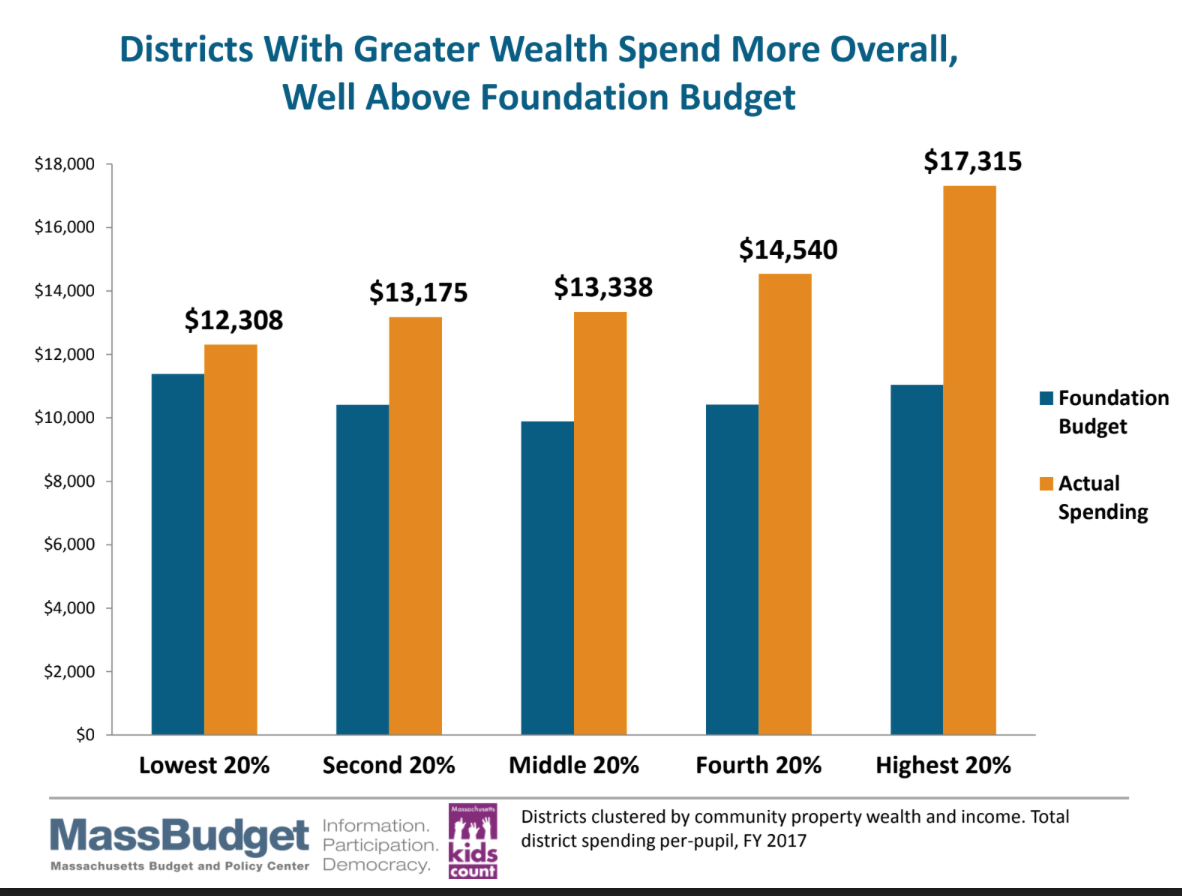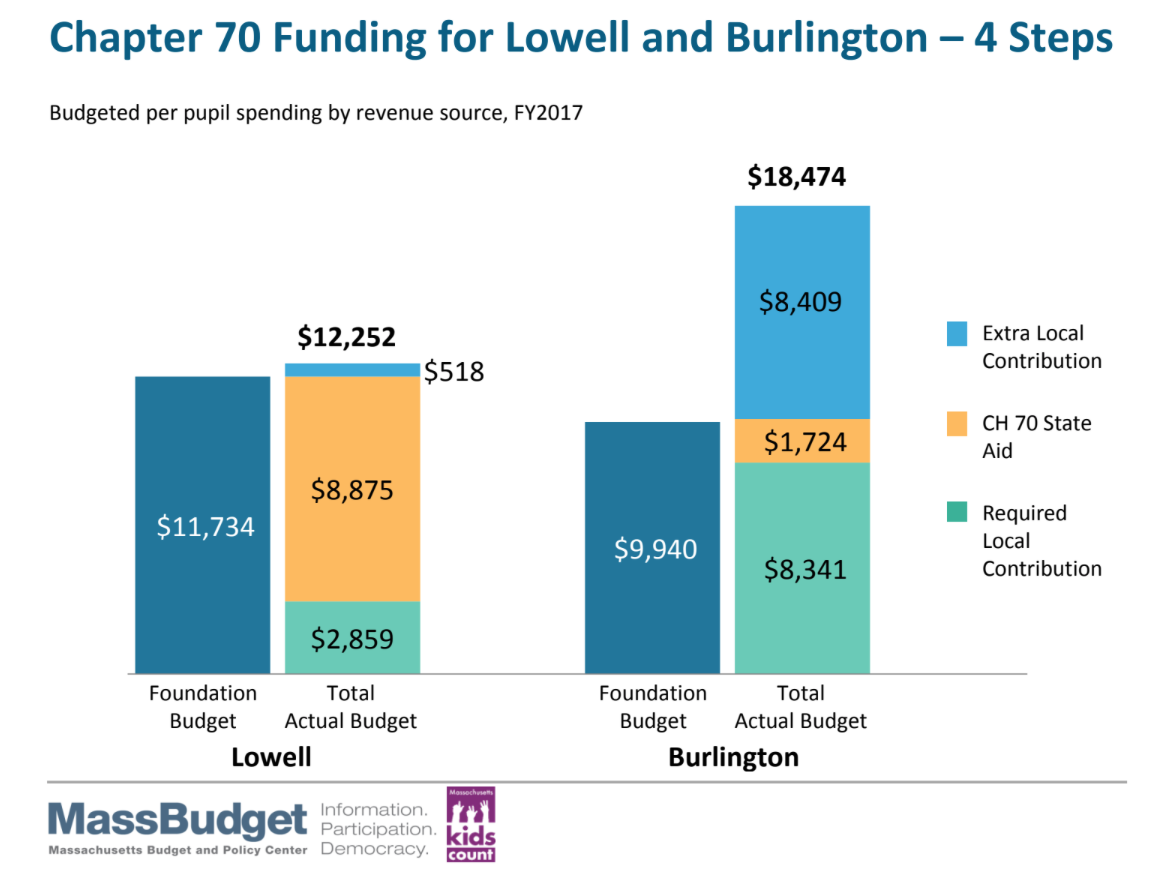The Envelop System of Foundation Budgets
When I first met my mother-in-law, I was totally fascinated by the organization she used to allocate family finances, the system we fondly refer to as the "envelop system". My mother-in-law would take an amount of money each week, break it down into smaller portions, and put each portion in its own coin-sized manila envelop which was kept handy throughout the week.
For example, if she budgeted $100 for food shopping throughout the week, five $20-bills would be put into the grocery envelop. When the money was gone, she either shifted cash from another envelop to buy something or went without until next payday.
In my mind, this is an apt analogy for what is happening in the Foundation Budget nightmare currently in place in our Commonwealth. The Commonwealth assigns a set dollar amount of aid for each community based on particular spending allocations, the chunk of money arrives at the municipality and when it doesn't fully cover one spending category, the schools shift the funding from one category to another that has been shorted.
However, one of the biggest issues with the Commonwealth's envelop system is that the money going into each envelop is the same amount as was used in 1993, over 25 years ago. Imagine trying to run your own household using the same amounts of cash as you comfortably spent in 1993.

Lowell Superintendents' Forum, 4/22/2019
In Lowell, we heard last Monday about a shortfall of nearly 500 classroom teachers each year. Big underfunded and under-calculated items in the Foundation Budget are surely contributing factors to this. If a district such as Lowell has huge differences between the Commonwealth's foundation budget determinations for school spending and the amount spent is more than what has been put aside, there are two choices.
Applying the "envelop system" demands a municipality either a) add money from the municipal coffers to make up that difference or b) shift funding from one category to another.
Of course these differences between state funding and actual spending are quite common - not to mention quite large - when the basis for the Foundation Budget calculations have not be updated in about 25 years. If state funding is based in the 1990s but actual expenses reflect the reality of 2019, it follows logically that there will be a huge conflict between state funding and reality. The differences are exacerbated when a municipality, like Lowell, Brockton, Springfield or Worcester, cannot contribute beyond what has been calculated in the Foundation Budget numbers, something a more affluent city of town might be able to do. It follows, then that some difficult educational budgeting choices must be made.
A gateway city, like Lowell, has nearly zero percent chance of not feeling some excruciating budget pain which brings us up to the shortfall of 500 classroom teachers. It is indeed painful to Lowell and to our children.
Four major areas - think of them as "envelopes" - need Foundation Budget reform: English Language Learners, Special Education (not including the Circuit Breaker), Health Insurance and Low Income. All of these funding categories are based on amounts that were set in 1993 which means that when one looks at what the Commonwealth funds and what the expense reality in 2019 is, there are huge variances.

Let's consider the budget "envelops" for a couple of these categories. The Foundation Budget calculates Special Education spending at $16.7 million, but the actual cost of Special Education in Lowell is $31.1 million. That's a difference of $14.4 million which has to come out of one of the other budget envelopes. Health Insurance as budgeted through the Foundation Budget calculations is figured at $17.3 million, but the actual insurance costs, even after switching to a cost-effective plan like the GIC, is $33.1 million. Surely no one in Massachusetts is expecting to pay the same insurance costs as they did in 1993, so is it any wonder that the Foundation Fund amount is so out of whack?
As a taxpayer, a voter, and as a former educator, I am shocked when local politicians claim there's no money to correct this. I think it is more likely there is no courage because that is what it will take to face the reality of underfunding schools. Revenues to fund schools, as well as transportation and infrastructure, in our Commonwealth are essential.
The envelop is empty and there is no time to waste.



 If a picture is worth a 1000 words, this one, courtesy of
If a picture is worth a 1000 words, this one, courtesy of  example: in neighboring Burlington, MA, the per pupil cost calculated $9,940. In Lowell, that base number is set at $11,734. Based on the economics of each community, the Commonwealth determined that Burlington's state aid be set at $1,724 leaving the remainder, $8,341, for the Town of Burlington to provide. Recognizing that Lowell's community economics are different from Burlington, the numbers look quite different: state aid is $8,875 and the City's required contribution is $2,859. In an effort the keep this "simple", which it is not, I'm ignoring the whole cash vs. "in kind services" debate.Burlington's per pupil costs are enhanced by the Town's ability to add $8,409 to what Massachusetts has determined is the cost of educating a student in that town. Lowell, with many more demands on its municipal budget, adds $518. So, in the end, Lowell is able to spend $12,252 on every school student (public and charter) while more affluent Burlington can allocate $18,474.This is not just a simple numbers game; it gets worse. Those per pupil determinations that the Commonwealth starts with are based on 1993 (yes, that is correct) formula calculations. So in 2018, the data determining how much each community is expected to expend and raise for each student is already 25 years out of date.The Foundation Budget Review Commission tackled this issue 2 years ago, but the recommendations were not implemented. It was not forgotten by everyone, however, and a refreshed bill, S.2525 unanimously passed the Massachusetts Senate last month. Now it's the Massachusetts House's turn. And this week, with some strong advocacy by Rep. Vega, House members are appealing to Speaker DeLeo to move this legislation out of the House Rules Committee and on to a floor for a vote.Locally, because state funding in education has been whittled away Lowell's kids are on the losing end of budget roulette: our K-8 students will no longer have school libraries, for example.As of this morning, only
example: in neighboring Burlington, MA, the per pupil cost calculated $9,940. In Lowell, that base number is set at $11,734. Based on the economics of each community, the Commonwealth determined that Burlington's state aid be set at $1,724 leaving the remainder, $8,341, for the Town of Burlington to provide. Recognizing that Lowell's community economics are different from Burlington, the numbers look quite different: state aid is $8,875 and the City's required contribution is $2,859. In an effort the keep this "simple", which it is not, I'm ignoring the whole cash vs. "in kind services" debate.Burlington's per pupil costs are enhanced by the Town's ability to add $8,409 to what Massachusetts has determined is the cost of educating a student in that town. Lowell, with many more demands on its municipal budget, adds $518. So, in the end, Lowell is able to spend $12,252 on every school student (public and charter) while more affluent Burlington can allocate $18,474.This is not just a simple numbers game; it gets worse. Those per pupil determinations that the Commonwealth starts with are based on 1993 (yes, that is correct) formula calculations. So in 2018, the data determining how much each community is expected to expend and raise for each student is already 25 years out of date.The Foundation Budget Review Commission tackled this issue 2 years ago, but the recommendations were not implemented. It was not forgotten by everyone, however, and a refreshed bill, S.2525 unanimously passed the Massachusetts Senate last month. Now it's the Massachusetts House's turn. And this week, with some strong advocacy by Rep. Vega, House members are appealing to Speaker DeLeo to move this legislation out of the House Rules Committee and on to a floor for a vote.Locally, because state funding in education has been whittled away Lowell's kids are on the losing end of budget roulette: our K-8 students will no longer have school libraries, for example.As of this morning, only  The Lowell High School project is, without a doubt, the biggest thing going in Lowell. I mainly stay out of the discussions about siting this project, mainly because, aside from being a taxpayer, I have very little skin in the game - no children/grandchildren in the school system. I do have an opinion, however, that is not based on tradition or the often-cited "that's the way we've always done it". That is one of the advantages of being a Blowellian.In my opinion, soliciting community support for this massive project has been ass-backwards from the start. My recollection is that, until there was some blowback from community groups like CBA and CMAA, there was very little effort to include all the stake-holders in the decision-making. Did the rush to get the project in front of Mass. School Building for project approval preclude the necessity for a referendum vote on where to put the school? I think it has.But while decisions and debate about where to put a new high school have become the focus point, there are other equally important issues that are getting pushed aside. One of those issues is the inadequate school funding support coming from the Commonwealth of Massachusetts.Thanks to cuts in the state budget and cuts coming from the Federal government, Lowell Public Schools needs to cut the previously approved 2018 budget by nearly $1 million. At the last School Committee meeting, there was plenty of debate surrounding the cutting of positions. Some of those proposed cuts are positions that directly impact students. The loss of anticipated Chapter 70 funding is somewhat complicated, but in my mind, these are the issues:
The Lowell High School project is, without a doubt, the biggest thing going in Lowell. I mainly stay out of the discussions about siting this project, mainly because, aside from being a taxpayer, I have very little skin in the game - no children/grandchildren in the school system. I do have an opinion, however, that is not based on tradition or the often-cited "that's the way we've always done it". That is one of the advantages of being a Blowellian.In my opinion, soliciting community support for this massive project has been ass-backwards from the start. My recollection is that, until there was some blowback from community groups like CBA and CMAA, there was very little effort to include all the stake-holders in the decision-making. Did the rush to get the project in front of Mass. School Building for project approval preclude the necessity for a referendum vote on where to put the school? I think it has.But while decisions and debate about where to put a new high school have become the focus point, there are other equally important issues that are getting pushed aside. One of those issues is the inadequate school funding support coming from the Commonwealth of Massachusetts.Thanks to cuts in the state budget and cuts coming from the Federal government, Lowell Public Schools needs to cut the previously approved 2018 budget by nearly $1 million. At the last School Committee meeting, there was plenty of debate surrounding the cutting of positions. Some of those proposed cuts are positions that directly impact students. The loss of anticipated Chapter 70 funding is somewhat complicated, but in my mind, these are the issues: